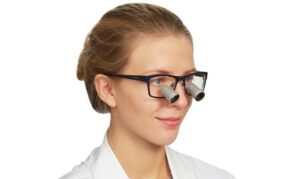Loupes are the type of instrument used by the dentist to examine teeth. It is a magnifying glass and helps to have a complete and clear view of the mouth during the checkup. Loupes are very helpful because it shows a magnified view of teeth and also relaxes the eye and back strain of the dentist for a proper checkup without any difficulties.
How Do Dental Loupes Work?
Dental loupes give about 2.8x greater magnification than the average human eye. Studies have shown that this range allows all clinicians to practice without disturbing the object in focus masterfully. This dental loupe allows the perfect visualization so that nothing can be missed during checkups.
High-quality lights are attached to loupes, showing the best view possible for precise work. High-quality lighting and magnification help detect many dental problems like plague build-up, tiny fractures, and pockets in the gums that possibly lead to periodontal disease.
Dentist loupes provide an accurate diagnosis with the appropriate treatment options for certain dental conditions. With the help of loupes, we can find out the issues that can lead us to severe problems in the future.
Benefits Of Dental Loupes
What is it that makes dental loupes so unique? The most common benefit of dental loupes is that they give a magnified and enhanced view of the patient’s mouth. This ensures that the dentist can be as efficient and accurate as possible.
Dentist loupes allow the dentist to be able to perform carefully and precisely the examinations, perform procedures or do fillings with an excellent level of competency and accuracy.

Talking at the cosmetic level, loupes help to match the colors of the filling as much as possible to the natural tooth—dentist loupes aid in accurately constructing and sculpting and repairing the result as close to perfection as possible.
Until now, you may have understood how critical dental loupes are to the dentist and the patients.
How do loupes differ from each other?
Several factors decide the type of loupes. Each loupe differs in magnification, resolution, depth of field, field of view, and much more.
Ideally, people want the lowest magnification that is optimal for the application. There is a general rule that if the magnification is less, the depth of field and field of vision is more significant. Simultaneously, the longer the working distance, the greater the field of view. If you have a larger field of view, then the less you need to move your head. This then reduces the strains on the eyes and fatigue.
The weight and fit of loupes also play an essential role. The lighter the weight of loupes, the more comfortable they are for a more extended period of use. If the fit is perfect, the dentist won’t need to worry about slipping the dental loupes from the nose while they work.
There are three main kinds of loupes that you will find in the market today:
- The single lens loupe for low magnification.
- Galilean loupe styled for multiple lenses offers 2.0x to 3.0x magnification.
- Prismatic loupes are chosen for even higher magnification, nearly up to 8.0 X.
Here are some factors to remember while getting a loupe:
- Resolution – The resolution helps to determine the value of fine details that can be seen. The resolution can be affected by the type of glass and the lens coatings applied to it. To check a set of loupes, look via them a graph paper. Then see the distorted colors and curvature of lines.
If that dentist loupe’s resolution is high, you will be able to see crisp straight lines. Meanwhile, the low-resolution loupes will show slightly blurred and curved lines.
- Working distance – The working distance is considered the optimum distance at which the loupe focuses. The working distance and distance from the loupe lens to the patient’s mouth must be identical. It will be better if you previously decide your working distance and then choose a loupe accordingly.
- Field of view – When you look through the loupe, the area seen in focus is the field of view. The higher the working distance, the greater the field of view of that loupe. Similarly, the less the magnification, the more the field of view will be.
- Depth of field – The depth of field is directly dependent on the magnification power and working distance. The depth of field is the depth that can be seen in focus when you look through that loupe. Greater depth of field is preferred as you can have a deeper look at the subject.
- Magnification – Magnification is the size of the image seen through the loupe. Higher magnification may provide a larger image but reduce the depth of field and field of view.
Bottom line
Loupes are the instruments that are used to magnify the working area mainly. These can vary depending on their magnification, field of view, working distance, and depth of field. The above listed are all the factors that make dental loupes differ from each other. Now, you will know everything about dentist loupes and how you can select the right one too.












